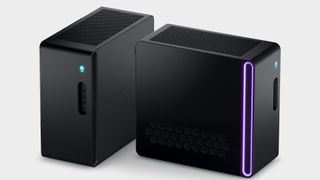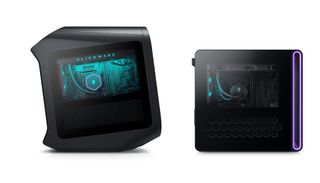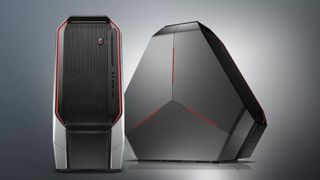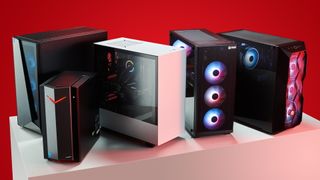Alienware's new Aurora R16 desktop PC is a deeply disappointing square box
Where's the flair, Alienware?

Remember when a new Alienware PC was something exciting? Yes, yes, you almost certainly weren't going to buy one. Even if you could afford them, Alienwares of old usually weren't actually the fastest PCs you could buy. But a bit like a Lamborghini that isn't actually as quick as a cheaper Porsche 911 Turbo, Alienware rigs didn't need to actually be the fastest. They always had that critical air of the exotic.
In short, the mere existence of Alienware PCs made the world a more interesting place. Well, not any more. Alienware's assimilation by the Dell corporate collective is now complete. The latest Alienware Aurora R16 has arrived and it's a generic mid-sized box.
In other words, it's absolutely nothing like Alienwares of yore, such as the slightly bonkers triangle-shaped Area-51. And it even lacks the somewhat bespoke aesthetic of the outgoing Aurora R15 and the similar R14 before that.
To be sure, the Aurora R15 was ultimately the same sort of machine as the new R16 inside. Indeed, the R16 offers exactly the same 25.2 liter internal volume as its predecessor and we believe the actual metal frame is the same with both systems. It's just the external plastic cladding that's changed.
Alienware says it's refined, streamlined and more space efficient. Certainly, the R16 is smaller and lighter. But it's also just another box. Bummer.

More to the point, what you now have is a generic looking box with Dell-Alienware style proprietary components that make future upgrades tricky. Kinda the worst of both worlds. At least when the chassis design was weird and wonderful you could slightly forgive elements like motherboards that didn't conform to the standard ATX definitions.
Anywho, apart from the now plain-vanilla proportions, what do you need to know about the new Aurora R16? Alienware says the optimised design delivers up to 10 percent lower CPU temps and six percent lower GPU temps. The machine is likewise said to be the quietest Aurora rig yet.
The biggest gaming news, reviews and hardware deals
Keep up to date with the most important stories and the best deals, as picked by the PC Gamer team.
You also get three RGB lighting zones, each composed of numerous individual LEDs. As standard, there's Wi-Fi 6E and an 80 Plus Platinum rated PSU in either 500W or 1000W spec. CPUs are Intel 12th and 13th gen items and graphics, predictably, is Nvidia RTX 40 series clobber.

Front ports comprise 10Gbps USB-C, three 5Gbps USB-A sockets and a 3.5mm headset jack. Round the back you get a 20Gbps USB-C port, another 10Gbps USB-C connection, two 5Gbps USB-As, and a pair of USB 2.0, along with 2.5Gbps ethernet and an array of audio out.

Best gaming PC: The top pre-built machines.
Best gaming laptop: Great devices for mobile gaming.
Prices start at $1,750 for an air-cooled Core i7 13700F plus Nvidia RTX 4070 graphics and scale from there. That base specs buys you 16GB of RAM and a 1TB NVMe SSD. A 13900F adds $150, while an upgrade to an RTX 4070 Ti is $200, so pretty much in line with the standard price delta between a 4070 and 4070 Ti.
For now, there are no higher GPU options, but they'll be added in due course.
Of course, one can legitimately query the practical value of Alienware's legacy designs. Was the quirky triangular chassis of the Area-51 actually the benefit to thermals that Alienware claimed back in 2014? Probably not. But it definitely looked cool, pun absolutely intended.
The new Aurora R16, by contrast doesn't look bad. It just doesn't really look like an Alienware. And exotic looks were, ultimately, what Alienware PCs were mostly about. And now we're not really sure what the brand stands for.

Jeremy has been writing about technology and PCs since the 90nm Netburst era (Google it!) and enjoys nothing more than a serious dissertation on the finer points of monitor input lag and overshoot followed by a forensic examination of advanced lithography. Or maybe he just likes machines that go “ping!” He also has a thing for tennis and cars.
Most Popular







